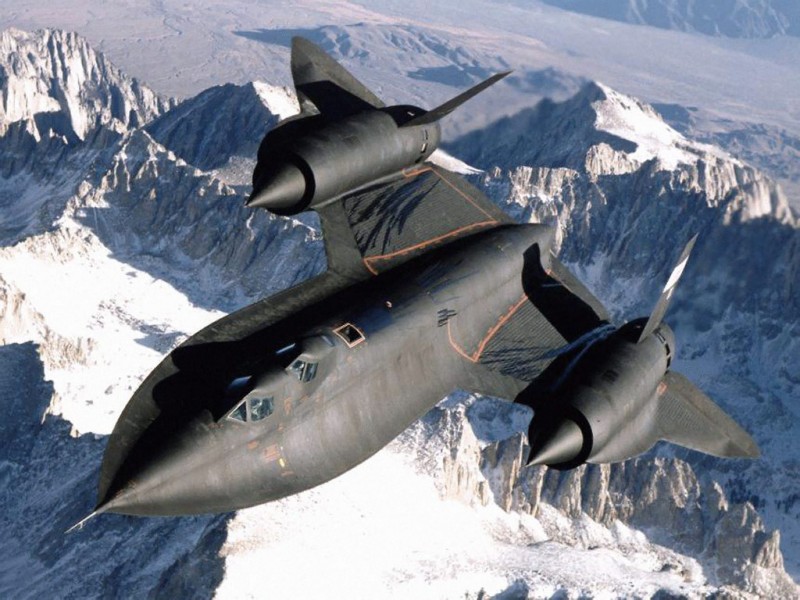We warned everyone, we are connoisseurs when it comes to the big, myriad and vast world of Automobiles and frankly Ujjwal and I never would have considered our site complete without the inclusion of this section, Aircraft. So here goes, our first of hopefully numerous posts on the world where life seems truly beautiful, the sky. The first post of this section is about probably the most revolutionary plane of the last 50 years, Lockheed Martin’s SR-71 also known as the Blackbird and as to why this section is being started and why we as auto-freaks follow this industry? I personally think that aircraft and specifically military aircraft are the yardstick for measuring the technological advancement of everyday motoring. People may argue that the racing industry is a better comparison but to be very true the world really isn’t as motivated to win races as it is to protect its borders and to travel as fast and efficiently as possible.
Imagine a combination of the best features of the Bugatti Veyron Supersport, Hummer H1, the radical styling of a Lamborghini and the respect of a Mclaren F1 and you probably have a preliminary idea about the SR-71 Blackbird. Picture this, this spaceship look-alike holds the record for the fastest air-breathing manned aircraft at 1,905.81 knots (2,193.2 mph; 3,529.6 km/h) since 1976, the record for the highest fixed wing flight at 85000 thousand feet (commercial aircraft fly at 35000 feet!), it has flown from New York to London in a record time of 1 hour 54 minutes 56.4 seconds at a speed of 1,435.587 miles per hour (2,310.353 km/h) and probably the coolest thing about this aircraft is the lack of anti missile features on the plane because all you needed to save yourself from incoming missiles while flying a SR-71 Blackbird is accelerate as it could out accelerate and outrun any missile of its time and to top it all it was made more than 50 years ago! No wonder games and movies produced even today captivate audiences with this exceptional plane.
Design : A stealth reconnaissance aircraft built in the 1960′s the SR-71 was one of the first in its class. Stealth technology was in its initial development stage when the SR-71 was made. The radical styling of the SR-71 and the sharp edges combined with a flat profile of the titanium shell of the Blackbird help to reduce its radar cross-section. A particularly difficult issue with flight at over Mach 3 is the high temperatures generated. As an aircraft moves through the air at supersonic speed, the air in front of the aircraft is compressed into a supersonic shock wave, and the energy generated by this heats the airframe. To address this problem, high-temperature materials were needed, and the airframe of the SR-71 was substantially made of titanium, obtained from the USSR at the height of the Cold War. Lockheed used many guises to prevent the Soviet government from knowing what the titanium was to be used for. In order to control costs, Lockheed used a more easily worked alloy of titanium which softened at a lower temperature. Finished aircraft were painted a dark blue, almost black, to increase the emission of internal heat (fuel acted as a heat sink for avionics cooling) and to act as camouflage against the night sky. The aircraft was designed to minimize its radar cross-section, an early attempt at stealth design. The aircraft’s call sign was “Blackbird”, because of its dark color. Fun Fact : The Blackbird’s fuel is stored, as it generally is in aircraft in the wings. However as the engineers had to keep space for expansion of the Titanium panel composing the wings. So the plane leaks fuel on the runway before take off. Nearly 80% of the fuel is lost by the time the plane is in the air. After a spin at Mach 1 during which the panels heat up due to friction and seal properly the SR-71 is refueled mid-air.
Engines : The Blackbird’s Pratt & Whitney J58-P4 engines were innovative marvels that used the most extreme materials of their time. Each J58 could produce 32,500lbf (145 kN) of static thrust. The only American engines designed to operate continuously on afterburner, the J58 engines were most efficient around Mach 3.2, and this was the Blackbird’s typical cruising speed. A unique hybrid, the engine can be thought of as a turbojet inside a ramjet. At lower speeds, the turbojet provided most of the compression and most of the energy from fuel combustion. At higher speeds, the turbojet largely ceases to provide thrust; instead, air was compressed by the shock cones and fuel burned in the afterburner. It is one of the very few aircraft that can operate at full afterburner for a sustained period of time without its compressor stalling.
Specifications (SR-71A)
General characteristics
- Crew: 2
- Payload: 3,500 lb (1,600 kg) of sensors
- Length: 107 ft 5 in (32.74 m)
- Wingspan: 55 ft 7 in (16.94 m)
- Height: 18 ft 6 in (5.64 m)
- Wing area: 1,800 ft2 (170 m2)
- Empty weight: 67,500 lb (30,600 kg)
- Loaded weight: 152,000 lb (69,000 kg)
- Max. takeoff weight: 172,000 lb (78,000 kg)
- Powerplant: 2 × Pratt & Whitney J58-1 continuous-bleed afterburning turbojets, 34,000 lbf (151 kN) each
- Wheel track: 16 ft 8 in (5.08 m)
- Wheelbase: 37 ft 10 in (11.53 m)
- Aspect ratio: 1.7
Performance
- Maximum speed: Mach 3.3 (2,200+ mph, 3,530+ km/h, 1,900+ knots) at 80,000 ft (24,000 m)
- Range: 2,900 nmi (5,400 km)
- Ferry range: 3,200 nmi (5,925 km)
- Service ceiling: 85,000 ft (25,900 m)
- Rate of climb: 11,810 ft/min (60 m/s)
- Wing loading: 84 lb/ft² (410 kg/m²)
- Thrust/weight: 0.44
